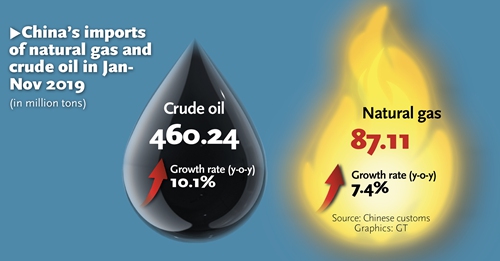HOME >> SOURCE
LNG imports from US likely to reach 15b cubic meters once deal signed
By Ma Jingjing and Wang Sheng Source:Global Times Published: 2020/1/9 21:03:41

Graphics: GT
China and the US have huge room for energy cooperation, and Chinese imports of liquefied natural gas (LNG) from the US are likely to reach about 15 billion cubic meters after a phase one trade deal is signed, Chinese experts said on Thursday.As Chinese Vice Premier Liu He is scheduled to lead a delegation to Washington next week to sign a phase one trade agreement with the US, there is speculation that China would drastically increase imports of US agricultural products, energy and services to meet domestic needs.
Experts told the Global Times that China's imports of LNG from the US will become a key breakthrough for the two to expand cooperation in the energy sector.
Before the trade war began in 2018, China's LNG imports from the US were growing rapidly.
"China purchased around 2.9 billion cubic meters from the US in 2017, up about six times year-on-year. If there hadn't been any trade friction, the figure might have already risen to 10-15 billion cubic meters," Jin Lei, an associate professor at the Beijing-based China University of Petroleum, told the Global Times on Thursday.
Before the trade war that was initiated by the US in the first place, China had signed several large LNG export deal with American suppliers, including one deal signed in November 2017 between Chinese companies including Sinopec and Bank of China and the US state of Alaska, but China then shifted to other suppliers like Qatar because of the start of China-US trade war.
"If a trade deal is signed, the US may account for a large proportion of China's LNG imports, which depends on the US' export price," Jin said.
China's LNG import increase is expected to mainly come from the US, Chen Zhanming, a deputy professor of the School of Applied Economics at Renmin University of China, told the Global Times on Thursday.
China is the world's largest natural gas importer. In 2018, China imported 90.39 million tons (about 125.9 billion cubic meters) of natural gas, data from the General Administration of Customs showed.
China mainly imports natural gas via pipelines and LNG. The latter comes from suppliers including Australia, Qatar, Southeast Asian nations and the US.
However, Chen said the US still has restrictions on China participating in its upstream natural gas exploration and development projects, which undercuts further energy cooperation.
Posted in: INDUSTRIES